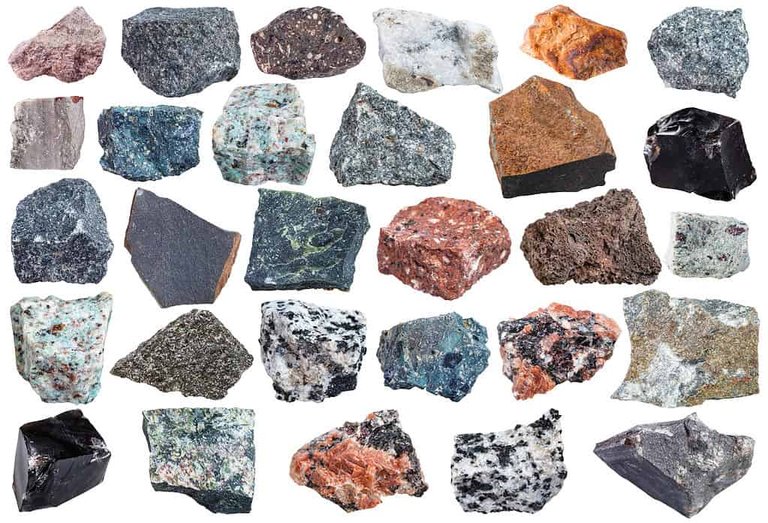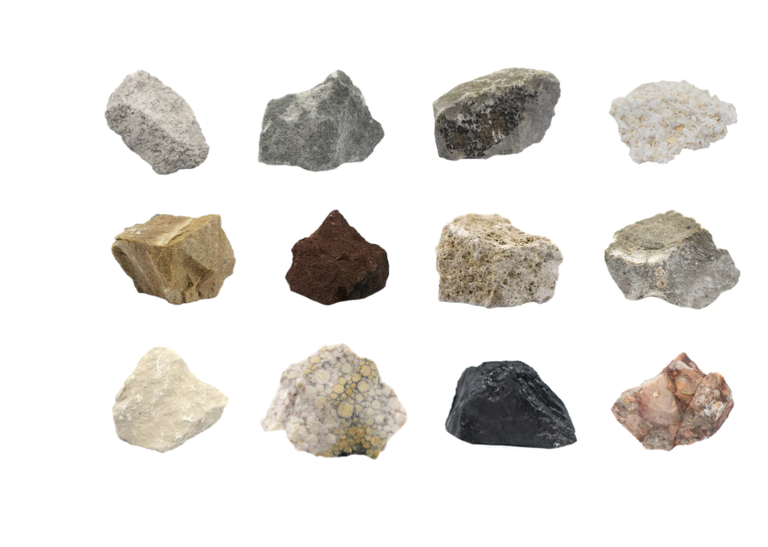Rock Chronicles
The rock is a hard, compact mass made up of clusters of minerals. They are a fundamental part of the Earth's crust and can vary widely in terms of composition, texture, and formation process. Rocks can range from being soft and easily erodible to hard and resistant. They serve as the building blocks of the Earth's geology and provide valuable insights into the planet's history and the processes that have shaped it over millions of years.
The study of rocks and the processes that shape them is known as geology. Geologists examine rocks to understand the Earth's history, the processes that have shaped its surface, and even to uncover valuable resources like minerals, metals, and fossil fuels.

All rocks are classified into three major types based on their origin, mode of formation and appearance. The three types of rock include;
1. Igneous Rock:

source
These are formed by the cooling and solidification of molten magma injected from beneath the earth's crust. This magma can be generated through processes like melting of the Earth's mantle due to heat and pressure changes, often associated with tectonic plate movement. When molten magma is forced upward and reaches the surface, it's referred to as lava.
As magma or lava cools, mineral crystals begin to form and interlock, giving rise to the unique textures and structures characteristic of igneous rocks. The rate of cooling influences the size of the mineral crystals; slower cooling typically results in larger crystals, while rapid cooling leads to smaller crystals or even glassy textures.
Igneous rock are broadly classified into two, namely;
a. Plutonic/intrusive Igneous Rock: Plutonic Igneous rock also known as intrusive igneous rock are formed when the molten magma cools and solidifies slowly before it gets to the surface of the earth to form large crystals. The term "intrusive" refers to the fact that these rocks are formed by the intrusion, or injection, of molten magma into existing rock formations below the Earth's surface. However, as a result of prolong erosion, the Intrusive igneous rock will later be exposed to the surface of the earth.
Examples of Intrusive Igneous rock are granite, gabbro and diorite.
b. Volcanic/Extrusive igneous rock: These are formed when the molten magma cools and solidifies rapidly on getting to the surface of the earth to form small crystals.
The term "extrusive" refers to the fact that these rocks are formed from magma that has been extruded, or erupted, onto the Earth's surface. While the term "volcanic" specifically emphasizes the connection of these rocks to volcanic activity.
Examples of Volcanic/Extrusive igneous rock are basalt, pumice, rhyolite, scoria, etc.
- They are glassy in appearance
- They are crystalline in nature
- They do not occur in layers (they are not stratified rocks)
- They don't contain fossils
- Igneous rocks are usually very hard
- They are resistant to erosion and other elements of climate
- They are light and dark in color
2. Sedimentary Rocks:
These are formed from sediments deposited by water, wind, or ice. These sediments accumulate in layers or strata and, over time, become hardened through compression and cementation, usually by organic matter or pressure, forming sedimentary rocks.
Examples of sedimentary rocks are limestone, sandstone, coal, mud stone, peat, lignite, shale and gypsum.
They occur in layers, strata or sheet
Sedimentary rocks are coarse in texture
They are non-crystalline (they do not exist in crystals)
They are not resistant to erosion and are very soft
They react with weak acid e.g. dilute Hcl.
3. Metamorphic Rock:

These are altered rocks. They are formed from pre-existing igneous or sedimentary rocks which have been changed as a result of pressure or great heat and chemically active fluids. This metamorphic process typically occurs deep within the Earth's crust and can result in changes to the mineral composition, texture, and structure of the original rock.
Examples of metamorphic rock include: Slate formed from limestone, Quartzite formed from sandstone, gneiss formed from graphite, schist formed from shale and graphite formed from coal.
Some may occur in layers or strata
They are hard and massive
They are non-crystalline
They exist in different colors and textures
They may contain fossils.

Rocks are source of plants nutrients like iron, calcium and potassium
Some rocks like graphite and sandstones are used for road and farm building construction
Rocks are used to make a pile up across sloppy land to prevent soil erosion
Rocks are useful as liming materials as they contain calcium and potassium
Some rocks are used in fertilizer blending in agriculture
Some rocks are used for sharpening farm tools like cutlasses and knives
Some beautiful rock such as marble can be polished as ornaments for decorating floors, walls of buildings etc.
Rocks are used as center of tourism e.g. Olumo rock in Ogun state
They serve as raw materials for industries e.g. limestone is used in the production cement and marble is used to produce glasses
Some Rocks are used for research purpose by scientist.
In conclusion, rocks are part of nature's art, They come in different types, like the fiery igneous rocks formed from melted material, the layered sedimentary rocks made from bits that piled up over time, and the transformed metamorphic rocks changed by heat and pressure.
These rocks have unique features. Some are hard and shiny, others are layered and crumbly, and some change their looks under pressure. They're not just old stones; they teach us about the past, help us build things, and give us clues about what's under the ground.


https://leofinance.io/threads/ngobaby/re-ngobaby-2zj3lpms7
The rewards earned on this comment will go directly to the people ( ngobaby ) sharing the post on LeoThreads,LikeTu,dBuzz.
Congratulations @ngobaby! You have completed the following achievement on the Hive blockchain And have been rewarded with New badge(s)
Your next target is to reach 600 replies.
You can view your badges on your board and compare yourself to others in the Ranking
If you no longer want to receive notifications, reply to this comment with the word
STOPCheck out our last posts:
Last read about rocks and it types when I was still a high school student. Never liked Geography as a course then as a student because the teacher then was never friendly and also create a scene of fear for students then but it's nice to know that rocks can be use to know the age of the earth. Please what instruments do they use for carrying out this study to know the age of the earth.
Good to know that rocks are also good for our plants as it provides calcium and iron to them which is also pass to us. Its importance are generally good and useful to man. Thank you very much for the post and lecture☺️☺️
Yay! 🤗
Your content has been boosted with Ecency Points, by @fokusnow.
Use Ecency daily to boost your growth on platform!
Support Ecency
Vote for new Proposal
Delegate HP and earn more
Thanks for your contribution to the STEMsocial community. Feel free to join us on discord to get to know the rest of us!
Please consider delegating to the @stemsocial account (85% of the curation rewards are returned).
You may also include @stemsocial as a beneficiary of the rewards of this post to get a stronger support.